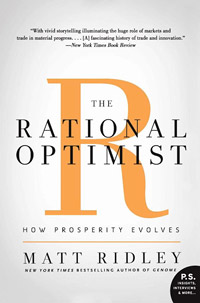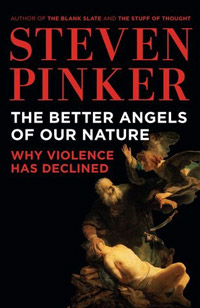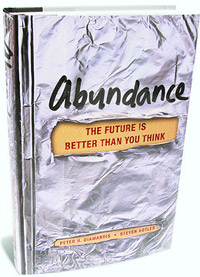In this week’s eSkeptic:

NEW ON SKEPTICBLOG.ORG
Teaching Allah and Xenu in Indiana
Michael Shermer criticizes the Indiana State Senate’s approval last month of a bill that would allow public school science teachers to teach religious origin stories in their classrooms, including those from: Christianity, Judaism, Islam, Hinduism, Buddhism, and Scientology.


Interview with David DiSalvo
SKEPTICALITY EPISODE 177
This week on Skepticality, Derek talks with David DiSalvo about his newest book, What Makes Your Brain Happy and Why You Should Do the Opposite, which delves into the ways in which we can recognize our brains’ faults and use them to live more fulfilled lives. DiSalvo is an award-winning public outreach and education specialist, and a popular writer for Scientific American Mind, Psychology Today, and other publications and blogs.
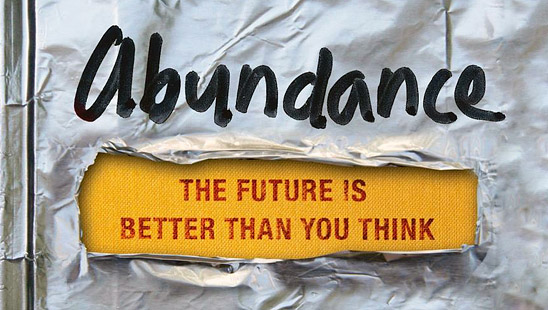
About this week’s eSkeptic
Rapidly advancing technologies may have the potential not only to spread information but to solve some of humanity’s most vexing problems. In this week’s eSkeptic, Michael Shermer reviews a just-released book called Abundance: The Future is Better Than You Think by Peter H. Diamandis and Steven Kotler (Free Press, ISBN: 978-14516-1421-3). Together they have produced a manifesto for the future that is grounded in practical day-to-day solutions addressing the world’s most pressing problems: overpopulation, food, water, energy, education, healthcare, and freedom. A slightly different version of this review was originally published in the Wall Street Journal on Wednesday, February 22.
It’s Getting Better All the Time
a review by Michael Shermer
If you read a major newspaper such as the New York Times or Wall Street Journal cover to cover every day for a week you will have consumed more digital information than a citizen in the 17th century Western world would have encountered in a lifetime. That’s a lot of digital data, but it’s nothing compared to what is on the immediate horizon. By comparison, from the earliest stirrings of civilization thousands of years ago to the year 2003, all of humankind created a grand total of five exabytes of digital information. An exabyte is one quintillion bytes, or one billion gigabytes. That’s a one followed by 18 zeros, and from 2003 through 2010 we created five exabytes of digital information every two days. By 2013 we will be producing five exabytes every ten minutes. How much information is this? The 2010 total of 912 exabytes is the equivalent of 18 times the amount of information contained in all the books ever written. This means that the world is not just changing, and the change is not just accelerating, but the rate of the acceleration of change is itself accelerating.
This and many other examples of accelerating returns are documented in Abundance: The Future is Better Than You Think by Peter H. Diamandis and Steven Kotler. Diamandis is the Chairman and CEO of the X PRIZE Foundation and the founder of more than a dozen high tech companies. Kotler is a journalist who writes for the New York Times magazine, Wired, Discover, GQ, and National Geographic. Together they have produced a manifesto for the future that is grounded in practical day-to-day solutions addressing the world’s most pressing problems: overpopulation, food, water, energy, education, healthcare, and freedom. They suggest that “humanity is now entering a period of radical transformation where technology has the potential to significantly raise the basic standard of living for every man, woman and child on the planet. Within a generation, we will be able to provide goods and services that were once reserved for the wealthy few to any and all who need them.” Accelerating change is happening in many areas:
- Information: A Masai warrior with a smartphone on Google has access to more information than the President of the United States did just 15 years ago.
- Technology: Today more people have access to a cell phone than a toilet.
- Computing: In 15 years, the average $1000 laptop should be computing at the rate of the human brain.
- Education: The Khan Academy’s YouTube tutorial videos on over 2200 topics from Algebra to Zoology draw over two million viewings a month.
- Medicine: The field of personalized medicine—an industry that didn’t exist before 2003—is now growing at 15 percent a year and will reach $452 billion by 2015.
- Aging: The centenarian population is doubling every decade, from 455,000 in 2009 to over 4.1 million by 2050.
- Poverty: The number of people living in absolute poverty has fallen since the 1950s and has dropped by more than half. At the current rate of decline it will reach zero by around 2035.
- Expenses: Groceries today cost 13 times less than 150 years ago in inflation adjusted dollars.
- Business: Billion dollar companies are being created faster than ever—YouTube grew from startup to $1.6 billion in 18 months; Groupon went from startup to $6 billion in two years.
- Standard of living: 95 percent of Americans now living below the poverty line have electricity, Internet, water, flushing toilets, a refrigerator and a television. John D. Rockefeller and Andrew Carnegie, among the richest people on the planet, enjoyed few of these luxuries.
The timing of this book is propitious. Between the 2011 Christian end-times soothsayers, the 2012 Mayan Calendar doomsayers, gloomy environmentalists, and the announcement in January by the Bulletin of Atomic Scientists that their Doomsday clock had been advanced to five minutes to midnight (and now includes environmental degradation and biological weapons alongside nuclear weapons as the likeliest candidates for our demise), how can anyone be so optimistic? With seven billion people now pressing up against the Earth’s carrying capacity there are seemingly intractable problems to be solved. Isn’t pessimism the appropriate response? Who’s right, the optimists or the pessimists?
The problem turns on cognitive biases that slant our interpretation of the data. Optimism is good for overcoming obstacles that are part of daily life, but over-optimism can blind one to adversities that should be heeded. In a Canadian study of inventors, for example, of those who participated in the Inventor’s Assistance Program in which they paid for objective evaluations of their invention on 37 different criteria, 47 percent continued working on their projects even after they were told that it was hopeless, and as a consequence they incurred losses double that of their more realistic colleagues. Optimism helps entrepreneurs override normal “loss aversion,” in which losses hurt twice as much as gains feel good, an emotion we evolved in our evolutionary environment of scarcity and uncertainty. Loss aversion leads most of us to be short term in our thinking. We discount the future in ways so predictable that economists have formulas to describe it. We focus on immediate events and bad news, and are blind to long-term trends and good news. Diamandis and Kolter not only acknowledge these cognitive biases, they address them head on as one more obstacle to abundance to be overcome.
I have long been skeptical of both doomsayers who project the end of the world in our generation, as well as futurists who proclaim that the Next Big Thing to revolutionize humanity and save the planet will happen in our lifetime. To date, the end-of-the world doomsters have been spectacularly and often embarrassingly wrong. And the futurists who craft a utopian narrative about how one day we will live forever, colonize the galaxy in starships, and materialize food and drink in replicators are indistinguishable from producers of science fiction and fantasy. Skeptics are from Missouri: Show Me. Diamandis and Kolter do just that, describing in specific detail how the revolution has already begun and that such abundance can be realized in our lifetime through three current forces:
- Do-It-Yourself (DIY) backyard tinkerers such as the aviation pioneer Burt Rutan, who won the X-Prize for achieving privatized space flight, and the geneticist J. Craig Venter, who beat the U.S. government in the race to sequence the human genome. Thousands of such DIYers are working away in garages and warehouses innovating solutions in neuroscience, biology, genetics, medicine, agriculture, robotics, and numerous other areas.
- Techno-philanthropists such as Bill Gates (malaria), Mark Zuckerberg (education), Pierre and Pam Omidyar (electricity in the developing world), and many more are dedicating significant portions of their vast fortunes to solving specific problems.
- The bottom billion, the poorest of the poor who have nowhere to go but up, as they become plugged into the global economy through micro-financing and the Internet will lift all boats with them as they work toward having clean water, nutritious food, affordable housing, personalized education, top-tier medical care, and ubiquitous energy. Don’t think of seven billion people as too many mouths to feed; think of them as seven billion brains who can think about solving heretofore insoluble problems.
The principles behind this process of abundance creation include: bottom-up v. top-down; non-linear v. linear; horizontal v. hierarchical; private entrepreneurship v. public works; small group v. large corporation; competition for prizes v. make-work for paycheck; risk disposed v. risk averse; Nonzero win-win v. zero-sum win-lose. The trend lines outlined by the authors are real enough, and if these principles were applied worldwide such abundance should indeed be realizable, in the long run if not in the short. The biggest hurdles, however, are not scientific or technological, but political. There are still too many corrupt dictators, third-world thugs, dear leaders, and backwards looking governments that would prefer corralling their people into medieval theocracies in order to enrich themselves. Still, as Matt Ridley demonstrated in The Rational Optimist and Steven Pinker in The Better Angels of Our Nature, even the political trend lines are moving in the right direction. In any case, as Diamandis likes to say: “The best way to predict the future is to create it yourself.”
Skeptical perspectives on the future…
-
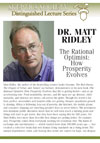 The Rational Optimist:
The Rational Optimist:
How Prosperity Evolves
with Dr. Matt Ridley
-
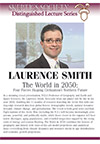 The World in 2050: Four Forces Shaping Civilization’s Northern Future
The World in 2050: Four Forces Shaping Civilization’s Northern Future
with Laurence Smith
-
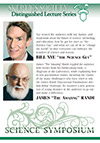 The Future of Science, Technology,
The Future of Science, Technology,
and Education
with Bill Nye and James Randi
Our Next Lecture: Dr. Eric Topol
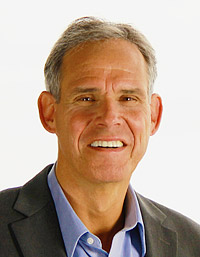
The Creative Destruction of Medicine: How the Digital Revolution Will Create Better Health Care
with Dr. Eric Topol
Sunday, March 11, 2012 at 2 pm
Baxter Lecture Hall
WHAT HAPPENS WHEN YOU COMBINE cellular phone technology with the cellular aberrations in disease? Or create a bridge between the digital revolution with the medical revolution? How will minute biological sensors alter the way we treat lethal illnesses, such as heart attacks or cancer? These questions, and more, are answered by Dr. Eric Topol, a leading cardiologist, gene hunter and medical thinker. Topol’s analysis draws us to the very frontlines of medicine and leaves us with a view of a landscape that is both foreign and daunting. As baby-boomers approach retirement age, they are going to be confronted with important choices among many new medical technologies. Don’t miss this important lecture based on Dr. Topol’s new book.
Tickets are first come, first served at the door. Seating is limited. $8 for Skeptics Society members and the JPL/Caltech community, $10 for nonmembers. Your admission fee is a donation that pays for our lecture expenses.
Followed by…
- Revelations: Visions, Prophecy, and Politics in the Book of Revelation
with Dr. Elaine Pagels
Monday, March 19, 2012 at 7:30 pm


